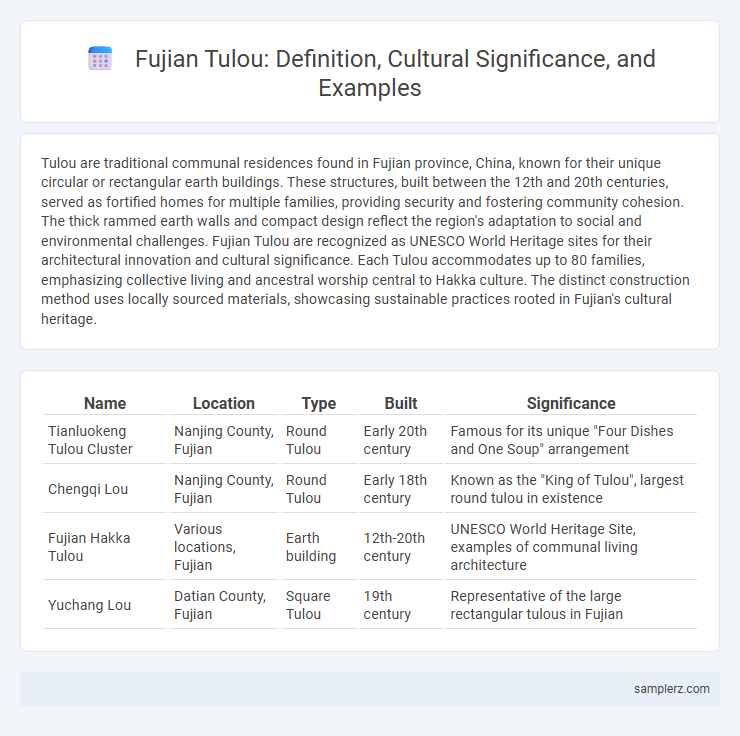Tulou are traditional communal residences found in Fujian province, China, known for their unique circular or rectangular earth buildings. These structures, built between the 12th and 20th centuries, served as fortified homes for multiple families, providing security and fostering community cohesion. The thick rammed earth walls and compact design reflect the region's adaptation to social and environmental challenges. Fujian Tulou are recognized as UNESCO World Heritage sites for their architectural innovation and cultural significance. Each Tulou accommodates up to 80 families, emphasizing collective living and ancestral worship central to Hakka culture. The distinct construction method uses locally sourced materials, showcasing sustainable practices rooted in Fujian's cultural heritage.
Table of Comparison
| Name | Location | Type | Built | Significance |
|---|---|---|---|---|
| Tianluokeng Tulou Cluster | Nanjing County, Fujian | Round Tulou | Early 20th century | Famous for its unique "Four Dishes and One Soup" arrangement |
| Chengqi Lou | Nanjing County, Fujian | Round Tulou | Early 18th century | Known as the "King of Tulou", largest round tulou in existence |
| Fujian Hakka Tulou | Various locations, Fujian | Earth building | 12th-20th century | UNESCO World Heritage Site, examples of communal living architecture |
| Yuchang Lou | Datian County, Fujian | Square Tulou | 19th century | Representative of the large rectangular tulous in Fujian |
Architectural Marvels: An Introduction to Fujian Tulou
Fujian Tulou exemplify traditional Chinese communal living with their fortified, cylindrical or rectangular structures designed to protect residents against bandits and natural disasters. These earthen buildings, constructed mainly from rammed earth, timber, and bamboo, can house up to 800 people, reflecting ingenious sustainable architecture developed between the 12th and 20th centuries. Recognized as UNESCO World Heritage Sites, Fujian Tulou remain significant symbols of Hakka culture and innovative rural architecture.
Historical Significance of Tulou in Fujian Culture
Tulou in Fujian are iconic earthen structures that reflect the region's unique communal living traditions and defensive architecture dating back to the Song and Ming dynasties. These multi-story, circular fortresses housed entire clans, symbolizing social cohesion and resilience against invasions. Recognized as UNESCO World Heritage Sites, Tulou embody Fujian's rich historical heritage and cultural identity.
Unique Design Elements of Fujian Tulou
Fujian Tulou, traditional communal residences in southeastern China, showcase unique design elements such as massive earthen walls constructed from compacted earth, providing remarkable insulation and durability. These circular or rectangular structures feature inward-facing rooms surrounding a central courtyard, fostering communal living and security against invaders. The tulou's distinctive architectural style incorporates wooden frameworks, intricate brickwork, and strategic ventilation systems, reflecting a blend of functional defense and harmonious social organization.
Communal Living: Social Structure Within Tulou
Fujian's tulou exemplify communal living through their unique social structure, housing multiple families within a single fortified building designed for collective defense and shared resources. These earthen structures foster close-knit communities by facilitating cooperation in daily activities, decision-making, and conflict resolution. The tulou's architectural layout promotes strong social cohesion, reflecting centuries-old traditions of mutual support and collective identity among residents.
Iconic Examples: Famous Tulou Clusters in Fujian
Famous tulou clusters in Fujian, such as the Tianluokeng Tulou Cluster in Nanjing County, showcase the unique communal living architecture of the Hakka people. These earthen structures, characterized by their circular and rectangular designs, provide exceptional insulation and defense mechanisms suited to the region's subtropical climate. Recognized as UNESCO World Heritage Sites, Fujian tulous embody centuries of cultural heritage and sustainable building practices.
Tulou and UNESCO World Heritage Recognition
Tulou in Fujian are traditional communal earthen buildings known for their distinctive circular and rectangular designs, serving as fortified residences for Hakka communities. These structures exemplify unique Chinese rural architecture, combining defensive features with communal living spaces, making them a significant cultural and historical symbol. Recognized by UNESCO as World Heritage Sites since 2008, Fujian Tulou highlight the innovative adaptation of building techniques to social and environmental needs.
Tulou in Modern Chinese Society
Tulou in Fujian, traditional communal earth buildings, symbolize resilience and cultural identity in modern Chinese society. These UNESCO World Heritage sites adapt to contemporary needs by serving as tourist attractions and cultural hubs, preserving Hakka heritage. Their architectural uniqueness blends ancient communal living concepts with modern sustainability trends.
Preservation Efforts for Tulou Architecture
Fujian's tulou, traditional earthen buildings housing multiple families, represent a unique cultural heritage of the Hakka people. Preservation efforts focus on restoring structural integrity using traditional materials while integrating modern techniques to prevent decay. UNESCO recognition and local government initiatives support conservation projects, promoting sustainable tourism and cultural education.
Tulou’s Influence on Contemporary Architecture
Tulou structures in Fujian exemplify innovative communal living designs that emphasize sustainability, natural ventilation, and earthquake resistance, influencing contemporary architecture globally. Modern architects integrate Tulou's circular layouts and thick rammed-earth walls into eco-friendly housing projects to enhance energy efficiency and community cohesion. This fusion of traditional Fujianese forms with modern materials fosters resilience and cultural continuity in urban developments.
Experiencing Tulou: Tourism and Cultural Exchange
Fujian's Tulou, traditional communal earthen buildings, offer immersive experiences where visitors engage directly with Hakka culture through guided tours and homestays. These UNESCO World Heritage sites provide unique opportunities for cultural exchange, showcasing traditional architecture, local customs, and folk arts. Tourism centered around Tulou fosters sustainable cultural preservation while promoting understanding of Hakka heritage.

example of "tulou" in "Fujian Infographic
 samplerz.com
samplerz.com